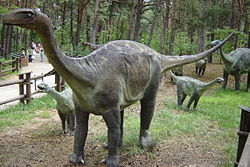| Vulcanodontidae | |
|---|---|
 | |
| Models of Vulcanodon in Poland | |
| Scientific classification | |
| Domain: | Eukaryota |
| Kingdom: | Animalia |
| Phylum: | Chordata |
| Clade: | Dinosauria |
| Clade: | Saurischia |
| Clade: | † Sauropodomorpha |
| Clade: | † Sauropoda |
| Clade: | † Gravisauria |
| Family: | † Vulcanodontidae Cooper, 1984 |
| Genera | |
| Synonyms | |
| |
The Early Jurassic sauropod dinosaurs Zizhongosaurus , Barapasaurus , Tazoudasaurus , and Vulcanodon may form a natural group of basal sauropods called the Vulcanodontidae. Basal vulcanodonts include some of the earliest known examples of sauropods. The family-level name Vulcanodontidae was erected by M.R. Cooper in 1984. [1] In 1995 Hunt et al. published the opinion that the family is synonymous with the Barapasauridae. [2] One of the key morphological features specific to the family is an unusually narrow sacrum.











